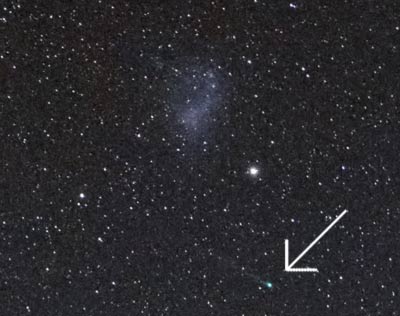Take THAT, Alien Scum!
SLATE
Posted
Wednesday, Feb. 27, 2013, at 11:32 AM
This is either:
a) The European Southern Observatory’s little known SHADO (Supreme
Headquarters of the Alien Defence Organization) group preventing yet
another alien invasion, or
2) A powerful laser beamed into the sky to help astronomers achieve higher-resolution images.
I’ll go with (2).
Which is true. The laser is shot into the sky, where, high above the
Earth’s surface, it energizes a layer of sodium atoms. The atoms glow,
mimicking the appearance of a bright, point-like star. Sensors
on the telescope then use that artificial star to account and
compensate for the boiling, roiling effects of the Earth’s air,
which smears out images of cosmic objects. Using sophisticated computer
techniques, the changing shape of the artificial star is used to
calculate the amount of atmospheric distortion, and a mirror with
pistons underneath is rapidly deformed to precisely compensate for it.
The result is far higher resolution observations, as well as the
incredible coolness of being able to fire a powerful laser into the
sky. The picture above,
taken by Gerhard Hüdepohl, shows the laser blasting away from one of
the Very Large Telescope’s four observatories to help the mammoth 8.2
meter mirrors see more clearly. The Milky Way hangs in the sky, nearly
parallel to the beam.
Off to the side, you can also see the two small satellite galaxies to
our Milky Way, called the Magellanic Clouds. It’s hard to spot in the
small picture, but if you grab the much larger version and look just below the smaller of the two Magellanic Cloud, you’ll see a greenish dot with a fuzzy streak trailing off of it:
That’s the comet C/2012 F6 Lemmon,
a relatively bright comet currently gracing the southern skies (sorry
Northern Hemisphereans, but we can’t see it). 2013 may well be the Year
of the Comet, with two more of the celestial intruders (Pan-STARRS and ISON) about to make themselves known. I’ll have more on these potentially very bright comets soon.
I’ll note you don’t need to worry about them impacting the Earth. Neither gets anywhere close enough to us to hurt us, but we are hoping they’ll put on a good show, getting easily bright enough to see.
And if they did get too close, well, we always have SHADO.




0 Comments:
Post a Comment
<< Home